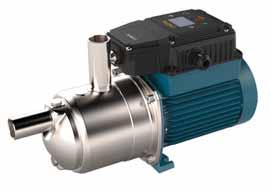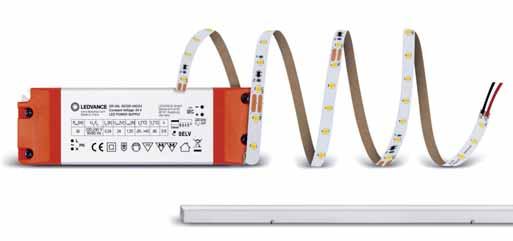
15 minute read
HVAC market trends

Pandemic accelerates decarbonised heating but … mixed picture for AC
Advertisement
BSRIA’s latest studies provide the most upto-date assessment of the impact Covid-19 has had on global demand for HVAC and building automation and controls products.


As the extent of the pandemic began to crystallise, a substantial part of the workforce employed in HVAC-related manufacturing in China was ordered to stay in quarantine. As a result, several manufacturing companies could not resume work, new construction projects were at a standstill, and installers were restricted to access sites. While restrictions and the quarantine extended to other countries, delays in the supply of air conditioning and heat pump products piled up during the March-April 2020 period.

Hydronic heating in China
The hydronic heating market in China is partly sustained by the coal-to-gas policy, and this part of the market recovered as soon as the pandemic became controlled with almost all projects carried out as previously planned. Similarly, the real estate market has recovered very fast and the pre-decoration policy is enforced widely. Thus, the project market for wall-hung boilers developed well in 2020 and is likely to keep
up with last year’s sales volume.
On the other hand, the retail market has been severely damaged by the pandemic as consumers’ wages shrunk and they naturally became cautious with their spending. Sales of hydronic heat pumps were also greatly affected in 2020 but demand is expected to recover to previous levels in 2021, boosted by resuming construction activity.
Impact on European market
Looking at the impact of the pandemic on the European markets, suppliers reported similar issues faced in the building sector. Most construction projects carried on at a slower pace while some were cancelled, and production lines at some HVAC manufacturers had to be put on hold for several weeks.
There are many common traits visible in every country, as Covid-19 caused lockdowns, impacted on construction, and triggered economic consequences which in turn diminished consumers’ purchasing power. HVAC manufacturers have been closely watching their expenditure, wholesalers reduced their inventories, installers have been staying away from work, and supply chains suffered interruptions. Costs for components, transport and labour crept up, but prices of equipment remained the same, putting a pressure on manufacturers’ margins.
Boiler and heat pump sales trends
Nevertheless, the measures in place to pull the market towards more energy efficient buildings and decarbonise heating proved to be successful. Many private households and project owners embraced their new way of living to undertake renovation works. In the meantime, installers took the time to upskill and promote the benefits of heat pumps over boilers. This trend, along with the financial support allocated to replace old heating systems, helped reverse the dip in heat pump sales in the new-build sector.
Overall, sales of heat pumps in France, Germany, Italy, the Netherlands, the UK and Ireland remained on an upward trend. Current forecasts until the end of the year point towards positive results in the main European markets. The package of financial incentives voted under the EU Recovery Fund are foreseen to keep demand growing, particularly in the replacement sector. BSRIA experts forecast 2020 to mark another year of strong progression in heat pump sales with double-digit growth rates likely to be posted in many European countries.
At the same time, the domestic boiler sector has been harder hit with sales reportedly down across quite a number of markets. Globally, in comparison to domestic boilers, sales of commercial boilers were affected to a lesser extent. Some sectors suffered more than others though, with projects in the hospitality market severely affected by the pandemic.
Building automation and controls
Building automation and controls (BACS) have a major role in improving HVAC system efficiencies. Sales of building automation system software have been performing better than the other control product segments so far in 2020, while valve and actuators have been suffering slightly more due to a decline in large projects. Suppliers are also reporting a shift towards more refurbishment work and an increase in service and maintenance activity. The overall building automation market is expected to be down compared to 2019 and will only recover to the previous year’s level in 2022.
As a second wave of infections is under way, the uncertainty surrounding the duration and severity of this crisis make it hard to anticipate how a recovery could unfold for the new construction industry in the medium term.
The recent announcement made by the EU Commission to dramatically reduce CO2 emissions by 2050 gives another strong and clear signal in favour of clean energy products. As a result, and with the help of financial support available to homeowners, further growth of renewables in the renovation sector is to be expected.
Mixed AC picture
The world air conditioning market reveals a mixed picture with the pandemic causing trading halts in parts of the world and disrupted global supply chains. BSRIA
9,000
8,000
7,000
6,000
5,000
4,000
3,000
2,000
1,000
0
2018 2019 2020(F) 2021(F) 2022(F) 2023(F) 2024(F)
interviewed key HVAC manufacturers and distributors in 20 major world markets and have consequently revised sales predictions for 2020 and 2021 on individual markets for key products such as splits, VRF, rooftops and chillers.
This new data is included in its latest Global AC Market Study published in September 2020. It provides the most up-to-date assessment of the global AC market performance for 2020, and expectations for the five years ahead.
The supply chain and production were disrupted across the world in the first six months of the year due to pandemic-related lockdowns. Chinese manufacturers closed their factories and shipments of goods came to a halt for several months. Not all countries were impacted in the same time, and not all products have been impacted in the same way. While most countries took a serious sales dive in the second quarter of the year, China experienced a sharp sales decline in the first quarter of 2020, and a gradual recovery from April on.
With many people working from home following Government advice, opportunities were created in the AC residential market, as consumers in many cases invested money saved on transport and leisure activities into having air conditioning installed over the summer. This was especially noted in Europe. Such attitudes have softened the blow and, as with other consumer products, online sales of residential AC products have increased sharply.
The light commercial market has been hit hardest with retail outlets, cafés and restaurants, hotels and other leisure facilities having to close. Typical products that are installed in these applications are large splits (>5kW) and VRF units. The sales fall in the hospitality industry was partly offset by the increased demand from buildings repurposed for healthcare premises, where VRFs with DOAS












































0.06 0.04 0.02 0 -0.02 -0.04 -0.06 -0.08 -0.1 -0.12 -0.14 0
World AC in 2020 by Volume
0.05
0.02 0.02
-0.08 -0.04
-0.06
-0.12 Splits VRF Roo ops Chillers
Pre-Covid-19 Post-Covid-19
Figure 2 – World AC market by volume in 2020 (Source: BSRIA).
(dedicated outdoor air system) were being installed to meet the required ventilation demand.
Today there is a growing demand for these products for offices where, along with implementing a safe working environment, there is a need to review the air quality and ensure sufficient fresh air in-take. Growth also came from the warehouse sector as the need for them grew in line with increasing on-line sales. In some countries government stimulus investments in the education sector further supported the market.
Overall, products mostly installed in medium to large non-residential projects have taken a deeper sales dive as these projects have often been disrupted by site closures, interrupted supply chains and social distancing rules, as well as absenteeism of migrant workers.
Under the current economic climate, a significant number of projects were also postponed or put on hold, according to the HVAC manufacturers. There is a greater need for sensors and controls which are integrated to BACS systems to “ monitor the air quality.


























































































New AC opportunities
Although the pandemic created challenges for HVAC companies, opportunities also opened up. In residential and non-residential applications there is a strong focus on further improvements in indoor air quality. This has created a particularly high demand for products which can self-clean, ventilate and offer air purification. Many manufacturers have now introduced new product lines to meet the demand. Going forward this is expected to become a trend.
In commercial applications, especially those with DX systems, the introduction of higher air volume is introduced with DOAS, zoning, filtration of recycled air and cleaning air ducts to reduce the risk of cross-infection in buildings. There is also a greater need for sensors and controls which are integrated to BACS systems to monitor the air quality and report on issues with any failing equipment.
Although there are many products, solutions and software in the market to achieve optimum IAQ, there is no market data which looks at the whole market. BSRIA’s Worldwide Market Intelligence team is currently working on a brand new study in this area. For information on these and other BSRIA publications contact: wmi@bsria.co.uk










